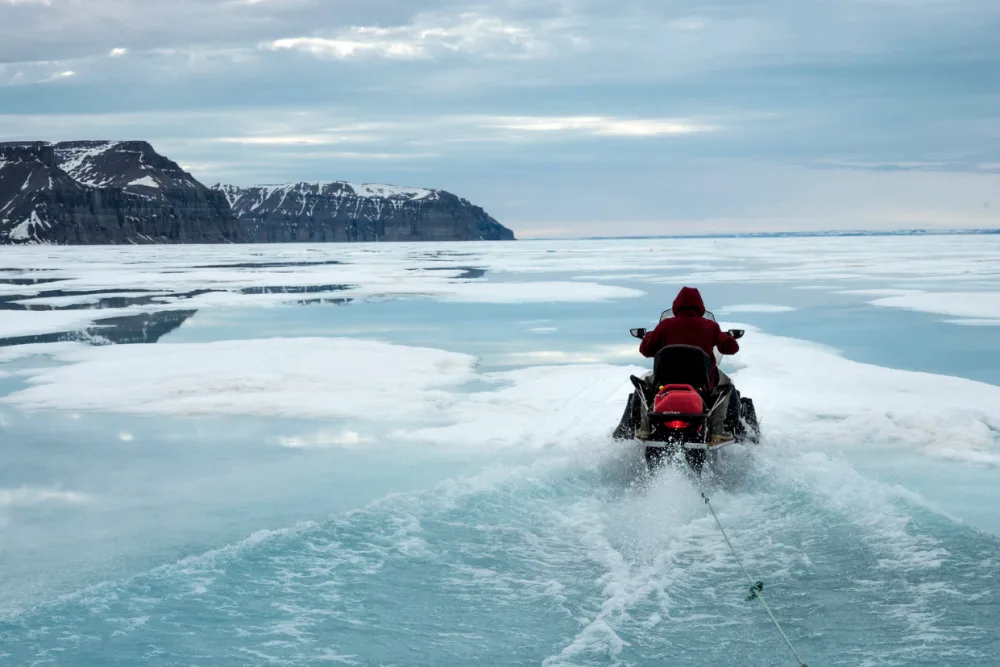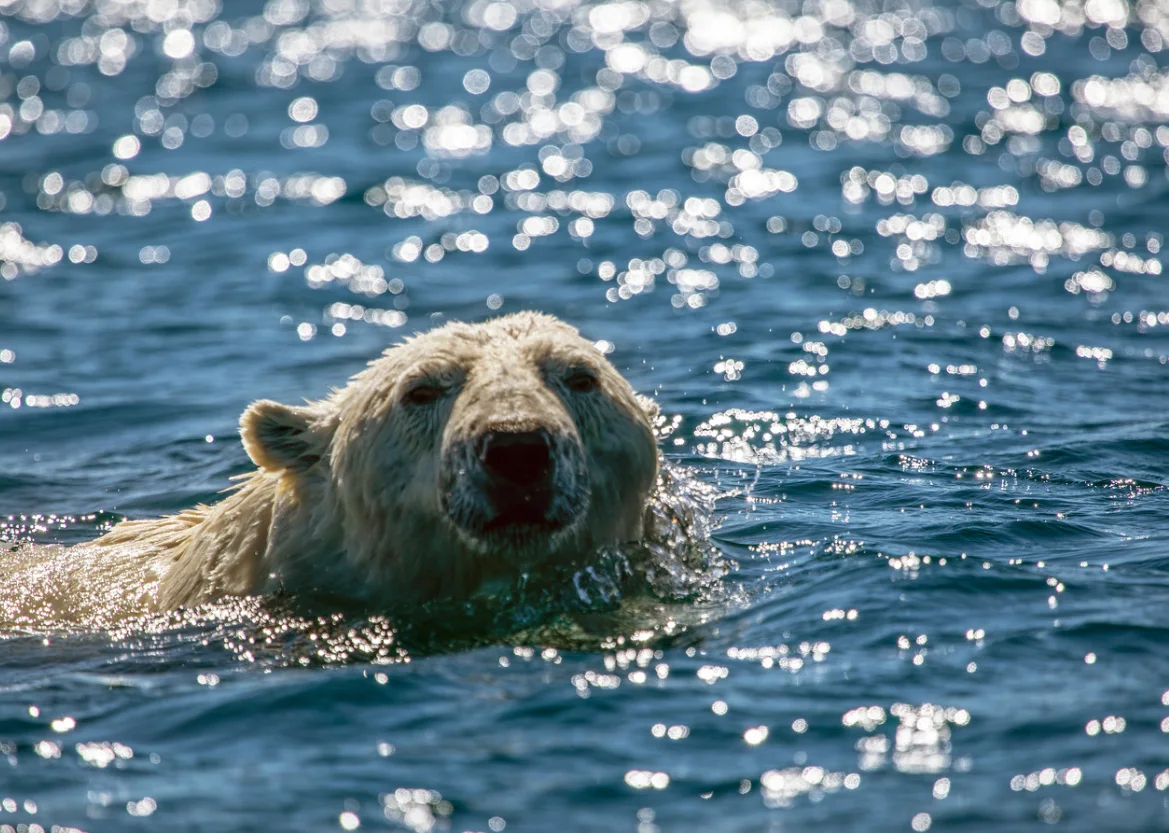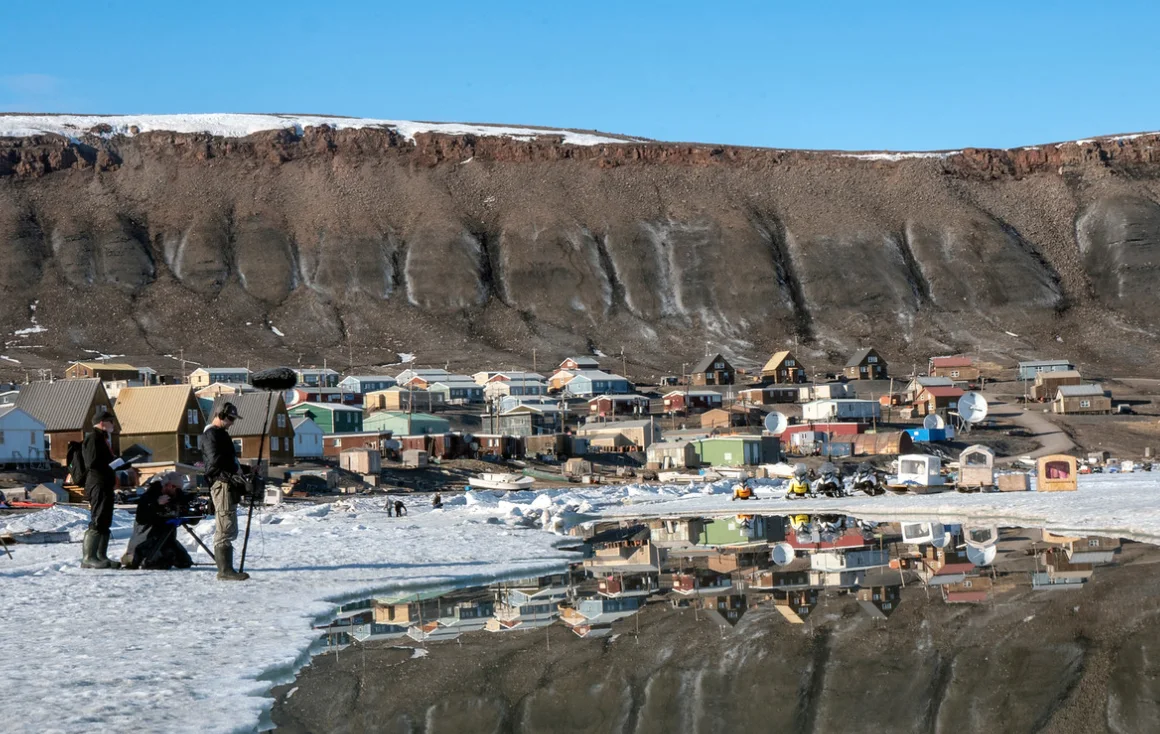
Diver recounts 'terrifying' impact of climate change in Canada's Arctic
Changing polar bear behaviours and flowing rivers from melting ice are just some of the most noticeable impacts from climate change in Canada's Arctic.
Diving in the Canadian Arctic is not for the faint of heart -- divers need extensive experience to navigate the bone-chilling waters, towering icebergs and polar wildlife that roam the frozen lands.
Despite the daunting conditions, Canadian extreme divers and cinematographers Jill Heinerth and Mario Cyr embarked on a journey to explore the Nunavut’s Naujaat region, located in the Arctic Circle, to document how the region is being impacted by climate change.
"All winter long water now flows up from beneath the snow into Inuit communities such as Arctic Bay and Pond Inlet, and they hadn't seen that before. There are rivers now flowing through town in the middle of winter...and that is terrifying," explains Heinerth.

Travelling across melting Arctic ice on a Ski-Doo. Credit: Jill Heinerth
Over 40 per cent of Canada's total landmass is in the Arctic and is home to hundreds of unique species including polar bears, narwhals, and walruses. The thousands of kilometres of ice blanketed with snow play a critical role in moderating the Earth's climate and storing millions of litres of fresh water, however, the Arctic is warming more than twice as fast as the rest of the planet.
Polar animals are responding to the changes in the physical environment and Heinerth says that imbalances in the food web are starkly apparent. "Since we have lost so much sea ice, polar bears these days are spending about seven weeks more in the water and on land than they used to even 25 years ago. While they used to hunt a seal around a breathing hole, they might be in the water hunting the seal," says Heinerth.
"What happens in the Arctic drives the entire global climate and so seeing these changes happening so dramatically so quickly, I mean it supports the science that's out there, but it's terrifying to see it firsthand."
WHY IS THE ARCTIC WARMING SO FAST?
Arctic amplification is occurring because warming temperatures since the early 1900s have caused significant amounts of Arctic ice to melt. As snow and ice melt the albedo decreases, meaning that reflective white surfaces are replaced by a larger area of darker surfaces, such as the ocean and ground, which are less reflective.
This creates an albedo feedback relationship – a greater amount of darker area becomes exposed when ice melts, which results in a greater amount of heat from the Sun being absorbed. The newly exposed darker areas retain this heat and the increased heat causes snow and ice to melt, and the cycle repeats.
Models indicate that as more carbon dioxide is released into the atmosphere, this warming cycle will continue and the risk for drastic landscape changes and significant biodiversity loss are becoming more likely in the Arctic.
"Icebergs are really the engine of biodiversity, so they bring nutrients from the land into the ocean and as they melt they supply the very base of the food chain," explains Heinerth.
THE DANGERS OF DIVING IN THE ARCTIC
Only experienced divers can safely venture into the frigid Arctic waters, which average from zero to -1°C. Divers can only spend up to 90 minutes during a dive and must constantly stay on alert for threats from polar animals.
Heinerth describes swimming with polar bears and walruses as "throwing yourself in the water like bait."
"Your little neoprene-covered head looks like a seal and a polar bear can swim very fast for a very long time and he will immediately chase after you no matter where you are in the ocean," explains Heinerth.

A polar bear spotted while diving in the Arctic. Credit: Jill Heinerth
With instruction from their Inuit guides and lots of practice, Heinerth and her team found the diving to be incredibly rewarding.
"When you first slip underneath the surface of the water you hear what sounds like an alien chorus. There are clicks coming from the narwhals, there's like a canary song coming from the belugas and the seal are trilling this sort of high to low sort of octave song, and they are all communicating, attracting mates talking about feeding...it’s so loud it is unbelievable, and then you return back to the surface and you hear just the wind and the snow...and it's quite different," describes Heinerth.
WHY DOCUMENTING CLIMATE CHANGE IN THE ARCTIC MATTERS
Heinerth and her team relied on Inuit people that act as their guides in the north and says that their wisdom and knowledge allowed them to explore the landscape and learn about how the changing climate impacts the Arctic.
Documenting climate change in the Arctic is one feat, however, filming a documentary while diving is an entirely different challenge. Heinerth and her team chose to dive into the frigid waters because they want people to see that climate change is having visible impacts and hope it creates a sense of urgency to act in any way they can to help solve the problem.

The reflection of Arctic Bay, an Inuit community located in the northern part of Baffin Island in Nunavut, in melting ice. Credit: Jill Heinerth
"When you really think about it their world is transforming, mainly because of occurring activities that they did not create, so it is incredible that they are so gracious, accepting, and helpful to help us understand what is going on," says Heinerth.
The Arctic is critical for a stable global climate and when asked what we can do to help fight this problem, Heinerth says that we all have a stake in the changing climate.
"If we all make the best next small step forward in our lives then that's the best that we can do to help solve these bigger issues, meaning living a more ecologically connected life, understanding that reducing reusing and recycling is important. Although you might feel like that's a small activity that may not have a huge effect, it does cumulatively, and it makes you part of the solution."
Under Thin Ice will be airing on CBC The Nature of Things and will be available on CBC Gem.
With files from Marta Czurylowicz.












